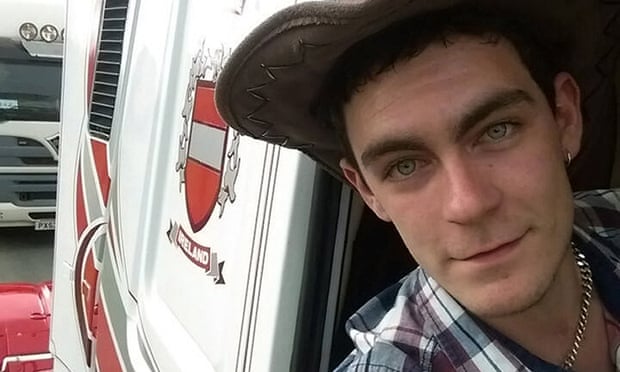39 lorry deaths: Police found over 500 exhibits
Police officers drive away a lorry in which the bodies of 39 people were discovered sparking a murder investigation at Waterglade Industrial Park in Grays, east of London, on Oct 23, 2019. Photo: AFP/Ben Stansall
Asked whether the focus of the investigation had now shifted from the Chinese to Vietnamese community, after the force initially declared the victims were Chinese, Senior Identification Manager Detective Chief Inspector Martin Pasmore on Oct 26 said: “The investigation hasn’t shifted anywhere. I’ve always remained completely open minded as to which nationalities I may have as my victims.”
He told reporters: “We cannot realistically speculate about the nationality of all of our deceased in that vehicle.”
Pasmore said he met Vietnamese Ambassador Tran Ngoc An on Saturday morning as part of efforts to engage with the country’s wider community, and that they were building “a really good and rapid rapport.” . The ambassador also visited and paid tribute to the victims at the civic centre in Grays.
Essex police said, all of the 39 people found in the lorry have now been moved from Tilbury Docks to Broomfield Hospital in Chelmsford.
The process to identify them and where they are from is continuing. This process works in tandem to the investigative process – as they look to both identify those who have died and identify and preserve any forensic evidence so that we can achieve justice for each of these victims and their loved ones.
This is the largest mass fatality victim identification process in the history of Essex Police.
They are using internationally-recognised standards of identification to identify the deceased. These are known as the INTERPOL Disaster Victim Identification Standards.
Disaster Victim Identification (DVI) is the internationally accepted term for the processes and procedures for recovering and identifying deceased people and human remains in multiple fatality incidents.
The process involves bringing together antemortem and postmortem information to make a positive identification by scientific means in a dignified manner, taking into account the needs of the investigation process, the needs of the bereaved and the needs of the community.
Victims are identified where possible, by at least one of the primary identification methods which are dental comparison, fingerprints and DNA.
Other, secondary, identification features are also taken into consideration, such as tattoos and scars. Supporting information to consider can include jewellery, clothing or property.
Once a preliminary identification has been made, trained liaison officers are deployed to support families.
Every victim a forensic scene. Officers are meticulously processing all the property that was with the victims and in the lorry and every item has an inpidual record made of it.
There are 39 victims and each appears to have a bag of some description, clothes, and other belongings, noted Essex police.
So far they have over 500 exhibits, including mobile phones which have to be downloaded and the interrogation of mobile phones will be important for identifying the victims but also assisting the wider investigation - this needs to be done in forensic way so it will pass the evidential process for court later.
However, as in any instance where a mass fatality has unfolded the police cannot predict how long this process will take.
“It may well be that there are people watching this tonight that are thinking ‘I’m here in the UK and I’m here illegally and I want to come forward, I want to obviously try and identify my loved ones and be reunited’, but they are frightened to come forward,” Pasmore said.
He explained he had met with a “facilitator” of one of the websites run for the Vietnamese community to help build trust between it and the police, hoping to encourage people to “take that leap of faith” and make contact with Essex police.
“If you come in to us we will do everything we can to put our arm around you, take you through this process, identify as quickly as possible to see whether or not we do indeed have one of your loved ones involved in this tragic incident,” he said.
He added that the Essex force was investigating lines of inquiry to “establish whether there is a wider conspiracy involved” in the deaths of the people found in the refrigerated lorry.
Fifth suspect arrested
 |
Mo Robinson is due to appear at Chelmsford magistrates court on Monday. Photograph: Rex/Shutterstock
The Crown Prosecution service has authorised Essex Police to charge a man in connection with the investigating the deaths of 39 people whose bodies were found in Grays on Wednesday.
According to The Guardian, shortly after a press conference outside Grays police station in Essex on Saturday (Oct 26), police in Ireland announced it had arrested a man in his early 20s at Dublin’s port wanted in relation to the case. Four people arrested earlier in the week remain in custody.
Maurice Robinson, 25, of Laurel Drive, Craigavon, Northern Ireland was arrested shortly after the discovery was made at the Waterglade Retail Park.He is due to appear at Chelmsford Magistrates’ Court on October 28 charged with 39 counts of manslaughter, conspiracy to traffic people, conspiracy to assist unlawful immigration and money laundering.
Three other people have been arrested in connection with this investigation.
A 38 year-old man and a 38 year-old woman from Warrington and a 48 year-old man from Northern Ireland, who were arrested on suspicion of conspiracy to traffic people and manslaughter remain in custody./.
VNF/The Guardian
Recommended
 World
World
Thailand Positions Itself As a Global Wellness Destination
 World
World
Indonesia Accelerates Procedures to Join OECD
 World
World
South Korea elects Lee Jae-myung president
 World
World
22nd Shangri-La Dialogue: Japan, Philippines boost defence cooperation
 World
World
Pakistan NCRC report explores emerging child rights issues
 World
World
"India has right to defend herself against terror," says German Foreign Minister, endorses Op Sindoor
 World
World
‘We stand with India’: Japan, UAE back New Delhi over its global outreach against terror
 World
World
